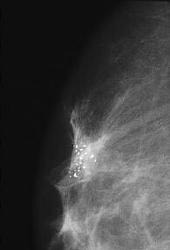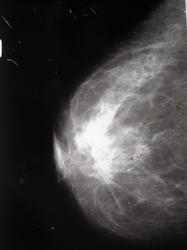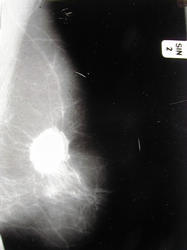Breast Imaging
1. Mammography
- Mammography uses ionizing radiation of low voltage (28-35 Mega-volts) to evaluate the breast.
- The technique is designed to demonstrate soft tissues of the breast (fibroglandular tissue).
- The glandular tissue of the breasts, or breast density, shows up as white areas on a mammogram film (figure 9-1).
Pathological findings in mammography
A. Calcifications: macro- and microcalcifications.
B. Mass densities (opacities).
C. Lymph nodes opacities.
D. Distortion of breast architecture.
Benign breast lesion
Benign lesions: (solid or cystic) are usually of variable size, solitary or multiple, regular shape, smooth well-defined border and not associated with microcalcifications or distortion of breast architecture .
Calcifications
1. Macrocalcifications: Macrocalcifications are coarse (large) calcium deposits that are often associated with benign fibrocystic changes or with degenerative changes in the breasts, and do not usually require a biopsy
2. Microcalcifications:
Microcalcifications are categorized to one of three groups:
1. Typically benign, Few, discrete, has the same shape
2. Intermittent type, lies between benign and malignant type
3. Highly suspicious of malignancy (figure 9-4): which has the following features:
a. Numerous: at least five to eight in number.
b. Clustered; aggregated in one part of the breast.
c. Polymorphic: differing from each other in size and shape: branched or V- or Y- shaped calcifications.
q Microcalcifications may or may not be associated with breast mass opacity.
Malignant breast lesion
Malignant tumors: are usually solitary, has irregular shape, ill-defined or speculated border, of high density and may or may not associated with microcalcifications and/or architectural distortion of the breast.
Distortion of breast architecture
Enlarged axillary Lymph nodes
Lymph nodes opacities are usually found in clusters and have kidney- or bean-shaped appearance with central or peripheral area of translucency representing the hilum of lymph nodes





